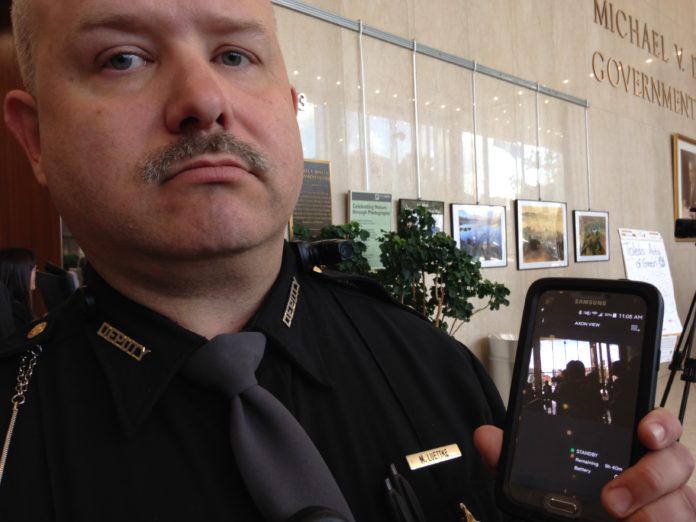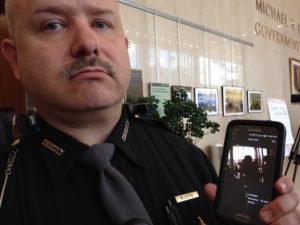

All Lucas County Sheriff’s Office deputy interactions with the public will now be recorded via body cameras, according to Sheriff John Tharp.
Tharp, flanked by Lucas County Commissioners, deputies and community officials, announced the implementation of the cameras April 21 at One Government Center. He first introduced the cameras in December and deputies have been using them since then as part of a trial period.
The commissioners have approved about $24,000 from their 2015 budget to be used for 17 cameras, which Tharp said will be turned on each time a deputy leaves his vehicle to interact with the public.
“All of the deputies are certainly excited about using the body cameras,” Tharp said. “It can be a win-win for the Lucas County Sheriff’s Office and for the community. … It does put everybody on their best behavior.”
The office’s body camera policy states cameras “shall be used to record all pedestrian and vehicle stops, pursuits, field interviews, calls for service and all other citizen contacts of an investigative nature.” At the end of the deputy’s shift, they will plug the camera into the evidence transfer manager, a docking station that simultaneously recharges the camera and downloads footage to evidence.com, a virtual warehouse storing digitally encrypted data. Fully charged cameras will be taken out on patrol by the next shift of deputies.
“As soon as they step out of the car, they will turn the camera on,” Tharp said. When asked what will happen if an officer forgets to do so, the sheriff said, “We will be turning them on. We’re not going to be covering up anything. We don’t need to be covering up anything.”
Tharp said nothing unusual turned up in video obtained by deputies during the office’s trial period of the cameras.
Commissioner Pete Gerken commended Tharp for taking a proactive step to protect the community and his deputies.
“Look, it’s a political and public policy concern,” Gerken said. “With the recent events in Baltimore (Freddie Gray, 25, died after suffering a severe spinal cord injury April 12 while in police custody), it’s just another chapter on how transparency has to be documented. This is a great tool. Transparency between the public and law enforcement is best documented by a body camera. We’ve seen citizens with cell phones participate in the process of recording officers, but I think the best view of any crime or incident between law enforcement and the public is best taken from the perspective of the law enforcement officer in the middle of the situation.”
Commissioner Tina Skeldon Wozniak compared the cameras to the police cruiser dashboard cameras that became prominent in the 1990s, saying body cameras will likely become an industry standard as well.
“The bottom line is this will create transparency and an objective record. At the end of the day, it will be very clear cut what occurred,” she said.
Rev. Donald L. Perryman, of United Pastors for Social Empowerment, stood by Tharp at the conference, as he did in December when the cameras were first announced.
“I approached Sheriff Tharp a few months ago, concerned about the increasing number of unarmed black men and women around the nation who were dying at the hands of law enforcement, and he said that he wanted to make a difference,” Perryman said. “[The camera] brings public trust and a cultural accountability in law enforcement to the forefront. Although these body cameras are not a panacea, they do serve as a strong deterrent to officer misconduct and excessive force, and they are a major step towards police reform in our area.”
Lt. Matt Luettke of the sheriff’s office does not typically go on patrol duty, but tried the cameras recently to become familiar with the technology his officers will be utilizing.
“I don’t see a downside to it from anyone’s perspective,” he said. “It will be good for evidence collection. We can use this video to prove things in court. … At crime scenes, it will be a lot less likely that things will be missed.
“Human interaction is never perfect,” Luettke said. “Everybody’s human, so there’s a lot of imperfect interaction, but this way we’ll be able to say ‘This took place and this didn’t.’”






















